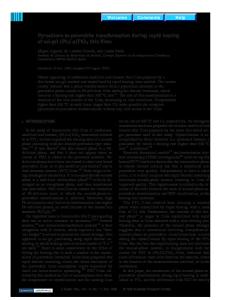Dielectric and Ferroelectric studies of Pb 0.85 La 0.15 TiO 3 Thin Films on solution derived RuO 2 Bottom Electrodes
- PDF / 113,168 Bytes
- 6 Pages / 612 x 792 pts (letter) Page_size
- 94 Downloads / 351 Views
Dielectric and Ferroelectric studies of Pb0.85La0.15TiO3 Thin Films on solution derived RuO2 Bottom Electrodes S. Bhaskar, S. B. Majumder, P. S. Dobal, S. B. Krupanidhi* and R. S. Katiyar Department of Physics, University of Puerto Rico, Rio Piedras campus, San Juan, PR 00931. *Materials Research Centre, Indian Institute of Science, Bangalore- 560012. India. ABSTRACT Sol-Gel derived Pb0.85La0.15TiO3 (PLT15) thin films were deposited on solution derived RuO2/Si, RuO2/Pt/Si and Pt bottom electrodes. Dielectric, tangent loss, hysteresis, J-E, measurements were also carried out on these films. X-ray results established the single phase perovskite formation with no secondary phases of PLT15 thin film on these electrodes. PLT15 thin films on RuO2 bottom electrode showed relatively inferior ferroelectric and dielectric behavior as compared to Pt electrode. Low leakage currents (10-8 A/cm2 at 10 kV/cm) and the observed J-E characteristics have been attributed to poor film-electrode interface. Observed electrical and dielectric properties have been correlated with the film-electrode interface. The interface characteristics were further augmented by depth profile analysis using Auger Electron Spectroscopy.
INTRODUCTION
Lead lanthanum titanate (PLT) is one of the most important ferroelectric materials because of its excellent dielectric, ferroelectric, pyroelectric and electro-optic properties. PLT thin films have been widely studied for applications in dynamic random access memories (DRAM), uncooled infrared detectors and electro-optic devices [1-4]. Several growth methods, including rf-sputtering [5], sol-gel [6], pulsed laser deposition [7], and chemical vapor deposition [8] techniques were employed to deposit PLT thin films. However, the sol-gel route, is a versatile method of preparing thin films, with several advantages, such as low processing temperature, non-vacuum process, low cost equipment, and large area deposition. In determining the performance of a ferroelectric thin film capacitor, electrodes (especially the bottom electrode) play an important role. The structural and electrical properties such as leakage current, dielectric properties, surface roughness, fatigue, and thermal stability are strongly related to the nature and state of the bottom electrode [9-12]. Therefore, several kinds of metal oxide and metallic compound electrodes have been suggested as alternatives to pure metal electrodes. Reports in the literature show that RuO2 bottom electrode reduced lattice mismatch and suppressed fatigue in ferroelectric thin films [9-11,13,14]. We have, therefore, prepared highly conductive, polycrystalline RuO2 bottom electrodes on platinized silicon and crystalline silicon substrates. In the present study, we have investigated dielectric and ferroelectric response of sol-gel derived Pb0.85La0.15TiO3 (PLT15) thin films on Pt, RuO2/Pt/TiO2/SiO2/Si, and RuO2/Si bottom electrodes. Direct evidence for reactive and interfacial compositional changes investigated by depth profile Auger electron spectroscopy was correlate
Data Loading...











